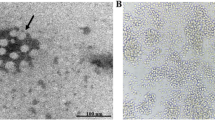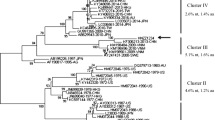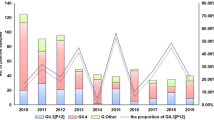Abstract
Noroviruses are the enteric pathogens most commonly responsible for infectious gastroenteritis and outbreaks of foodborne illness. The GII.4 norovirus, in particular, is responsible for the majority of epidemics. Here, we present data on the distribution of norovirus genotypes in Chungnam, Korea, in 2008, measure genetic variation among GII.4 strains, and compare Korean GII.4 variants with reference strains based on the 237-bp junction of ORF1 and ORF2. We detected 139 different strains, which formed two distinct genetic clusters with significant sequence diversity. One Korean cluster (2008-Korea_a) showed high similarity to the Sakai cluster that appeared in Japan and Europe in 2006. The other cluster (2008-Korea_b) was unique and unrelated to previously reported clusters. Genotype GII.4 was confirmed as the predominant cause of norovirus epidemics in Korea. Foodborne norovirus infections, on the other hand, were generally caused by emerging GII.4 genetic variants similar to those responsible for global epidemics.

Similar content being viewed by others
References
Ambert-Balay K, Bon F, Le Guyader F, Pothier P, Kohli E (2005) Characterization of new recombinant noroviruses. J Clin Microbiol 43:5179–5186
Armanda-Michel J, Giannella RA (1999) Acute diarrhea: a practical review. Am J Med 106:670–676
Boga JA, Melón S, Nicieza I, De Diego I, Villar M, Parra F, De Oña M (2004) Etiology of sporadic cases of pediatric acute gastroenteritis in Asturias, Spain and genotyping and characterization of norovirus strains involved. J Clin Microbiol 42:2668–2674
Bok K, Abente EJ, Realpe-Quintero M, Mitra T, Sosnovtsev SV, Kapikian AZ, Green KY (2009) Evolutionary dynamics of GII. 4 noroviruses over a 34-year period. J Virol 83(22):11890–11901
Bull RA, Hansman GS, Clancy LE, Tanaka MM, Rawlinson WD, White PA (2005) Norovirus recombination in ORF1/ORF2 overlap. Emerg Infect Dis 11:1079–1085
Bull RA, Tu ET-V, McIver CJ, Rawlinson WD, White PA (2006) Emergence of a new norovirus genotype II.4 variant associated with global outbreaks of gastroenteritis. J Clin Microbiol 44:327–333
Dingle KE (2004) Mutation in a Lordsdale norovirus epidemic strain as a potential indicator of transmission routes. J Clin Microbiol 42:3950–3957
Dove W, Cunliffe NA, Gondwe JS, Broadhead RL, Molyneux ME, Nakagomi O, Hart CA (2005) Detection and characterization of human caliciviruses in hospitalized children with acute gastroenteritis in Blantyre, Malawi. J Med Virol 77:522–527
Fankhauser RL, Noel JS, Monroe SS, Ando T, Glass RI (1998) Molecular epidemiology of “Norwalk-like viruses” in outbreaks of gastroenteritis in the US. J Infect Dis 178:1571–1578
Fretz R, Svoboda P, Lüthi TM, Tanner M, Baumgartner A (2005) Outbreaks of gastroenteritis due to infections with norovirus in Switzerland, 2001–2003. Epidemiol Infect 133:429–437
Glass RI, Bresee J, Jiang B, Gentsch J, Ando T, Fankhauser R, Noel J, Parashar U, Rosen B, Monroe SS (2001) Gastroenteritis viruses: an overview. Novartis Found Symp 238:5–19
Hale AD, Crawford SE, Ciarlet M, Green J, Gallimore C, Brown DW, Jiang X, Estes MK (1999) Expression and self-assembly of Grimsby virus: antigenic distinction from Norwalk and Mexico viruses. Clin Diagn Lab Immunol 6(1):142–145
Ho EC, Cheng PK, Lau AW, Wong AH, Lim WW (2007) Atypical norovirus epidemic in Hong Kong during summer of 2006 caused by a new genogroup II/4 variant. J Clin Microbiol 45:2205–2211
Huh JW, Kim WH, Moon SG, Lee JB, Lim YH (2009) Viral etiology and incidence associated with acute gastroenteritis in a 5-year survey in Gyeonggi province, South Korea. J Clin Virol 44:152–156
Iijima Y, Tanaka S, Ohishi H (2008) Multiple outbreaks of gastroenteritis due to a single strain of genotype GII/4 norovirus in Kobe, Japan, 2006: risk factors for norovirus spread in health care settings. Jpn J Infect Dis 61(5):419–422
Kroneman A, Vennema H, Harris J, Reuter G, von Bonsdorff CH, Hedlund KO, Vainio K, Jackson V, Pothier P, Koch J, Schreier E, Böttiger BE, Koopmans M (2006) Increase in norovirus activity reported in Europe. Euro Surveill 11:E061214.1
Lopman B, Vennema H, Kohli E, Pothier P, Sanchez A, Negredo A, Buesa J, Schreier E, Reacher M, Brown D, Gray J, Iturriza M, Gallimore C, Bottiger B, Hedlund KO, Torvén M, von Bonsdorff CH, Maunula L, Poljsak-Prijatelj M, Zimsek J, Reuter G, Szücs G, Melegh B, Svennson L, van Duijnhoven Y, Koopmans M (2004) Increase in viral gastroenteritis outbreaks in Europe and epidemic spread of new norovirus variant. Lancet 363:682–688
Marshall JA, Dimitraidis A, Wright PJ (2005) Molecular and epidemiological features of norovirus-associated gastroenteritis outbreaks in Victoria, Australia in 2001. J Med Virol 75:321–331
Medici MC, Martinelli M, Abelli LA, Ruggeri FM, Di Bartolo I, Arcangeletti MC, Pinardi F, De Conto F, Izzi G, Bernasconi S, Chezzi C, Dettori G (2006) Molecular epidemiology of norovirus infections in sporadic cases of viral gastroenteritis among children in Northern Italy. J Med Virol 78:1486–1492
Motomura K, Oka T, Yokoyama M, Nakamura H, Mori H, Ode H, Hansman GS, Katayama K, Kanda T, Tanaka T, Takeda N, Sato H (2008) Identification of monomorphic and divergent haplotypes in the 2006–2007 norovirus GII/4 epidemic population by genomewide tracing of evolutionary history. J Virol 82(22):11247–11262
Noel JS, Ando T, Leite JP, Green KY, Dingle KE, Estes MK, Seto Y, Monroe SS, Glass RI (1997) Correlation of patient immune responses with genetically characterized small round-structured viruses involved in outbreaks of nonbacterial acute gastroenteritis in the United States, 1990 to 1995. J Med Virol 53(4):372–383
Noel JS, Fankhauser RL, Ando T, Monroe SS, Glass RI (1999) Identification of a distinct common strain of “Norwalk-like viruses” having a global distribution. J Infect Dis 179:1334–1344
Saitou N, Nei M (1987) The neighbor-joining method: a new method for reconstructing phylogenetic trees. Mol Biol Evol 4:406–425
Schmid D, Lederer I, Pichler AM, Berghold C, Schreier E, Allerberger F (2005) An outbreak of norovirus infection affecting an Austrian nursing home and a hospital. Wien Klin Wochenschr 117:802–808
Seah EL, Marshall JA, Wright PJ (1999) Open reading frame 1 of the Norwalk-like virus Camberwell: completion of sequence and expression in mammalian cells. J Virol 73(12):10531–10535
Siebenga JJ, Vennema H, Renckens B, de Bruin E, van der Veer B, Siezen RJ, Koopmans M (2007) Epochal evolution of GGII.4 norovirus capsid proteins from 1995 to 2006. J Virol 81(18):9932–9941
Siebenga JJ, Beersma MF, Vennema H, van Biezen P, Hartwig NJ, Koopmans M (2008) High prevalence of prolonged norovirus shedding and illness among hospitalized patients: a model for in vivo molecular evolution. J Infect Dis 198(7):994–1001
Takkinen J (2006) Recent norovirus outbreaks on river and seagoing cruise ships in Europe. Euro Surveill 11:E060615 2
Thompson JD, Higgins DG, Gibson TJ (1994) Clustal W: improving the sensitivity of progressive multiple sequence alignment through sequence weighting, position-specific gap penalties and weight matrix choice. Nucleic Acids Res 22:4673–4680
Tsugawa T, Numata-Kinoshita K, Honma S, Nakata S, Tatsumi M, Sakai Y, Natori K, Takeda N, Kobayashi S, Tsutsumi H (2006) Virological, serological, and clinical features of an outbreak of acute gastroenteritis due to recombinant genogroup II norovirus in an infant home. J Clin Microbiol 44:177–182
Tu ET, Nguyen T, Lee P, Bull RA, Musto J, Hansman G, White PA, Rawlinson WD, McIver CJ (2007) Norovirus GII.4 strains and outbreaks, Australia. Emerg Infect Dis 13:1128–1130
Tu ET, Bull RA, Greening GE, Hewitt J, Lyon MJ, Marshall JA, McIver CJ, Rawlinson WD, White PA (2008) Epidemics of gastroenteritis during 2006 were associated with the spread of norovirus GII.4 variants 2006a and 2006b. Clin Infect Dis 46:413–420
Vinjé J, Hamidjaja RA, Sobsey MD (2004) Development and application of a capsid VP1 (region D) based reverse transcription PCR assay for genotyping of genogroup I and II noroviruses. J Virol Methods 116:109–117
White PA, Hansman GS, Li A, Dable J, Isaacs M, Ferson M, McIver CJ, Rawlinson WD (2002) Norwalk-like virus 95/96-US strain is a major cause of gastroenteritis outbreaks in Australia. J Med Virol 68:113–118
Widdowson MA, Cramer EH, Hadley L, Bresee JS, Beard RS, Bulens SN, Charles M, Chege W, Isakbaeva E, Wright JG, Mintz E, Forney D, Massey J, Glass RI, Monroe SS (2004) Outbreaks of acute gastroenteritis on cruise ships and on land: identification of a predominant circulating strain of norovirus-United States, 2002. J Infect Dis 190:27–36
Wilhelmi I, Roman E, Sanchez-Fauquier A (2003) Viruses causing gastroenteritis. Clin Microbiol Infect 9:247–262
Zheng DP, Ando T, Fankhauser RL, Beard RS, Glass RI, Monroe SS (2006) Norovirus classification and proposed strain nomenclature. Virology 346:312–323
Acknowledgments
This study was supported by a grant from the Korea Healthcare Technology R&D Project, Ministry for Health, Welfare & Family Affairs, Republic of Korea (A085119).
Author information
Authors and Affiliations
Corresponding author
Rights and permissions
About this article
Cite this article
Park, K.S., Jeong, H.S., Baek, K.A. et al. Genetic analysis of norovirus GII.4 variants circulating in Korea in 2008. Arch Virol 155, 635–641 (2010). https://doi.org/10.1007/s00705-010-0627-y
Received:
Accepted:
Published:
Issue Date:
DOI: https://doi.org/10.1007/s00705-010-0627-y




